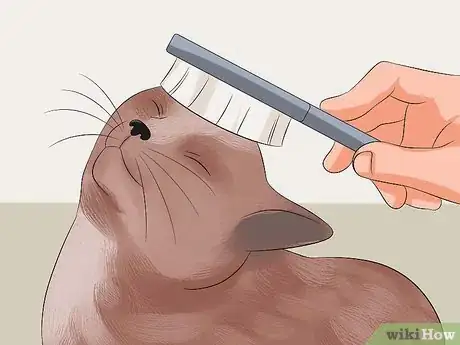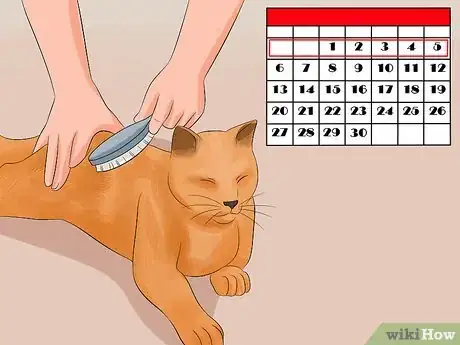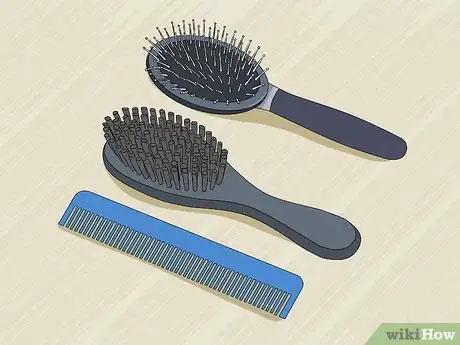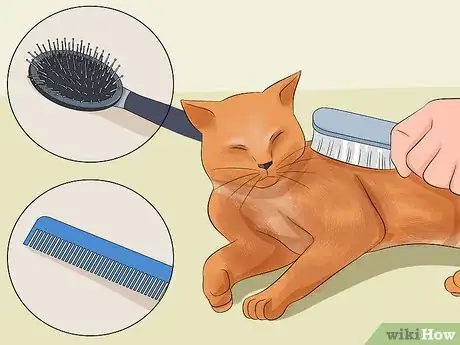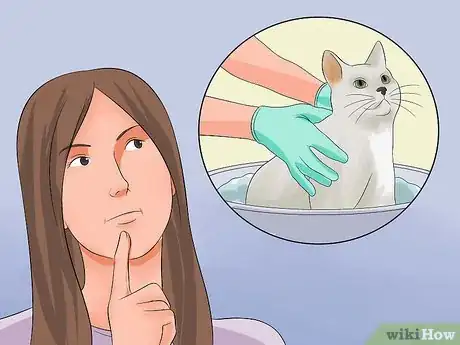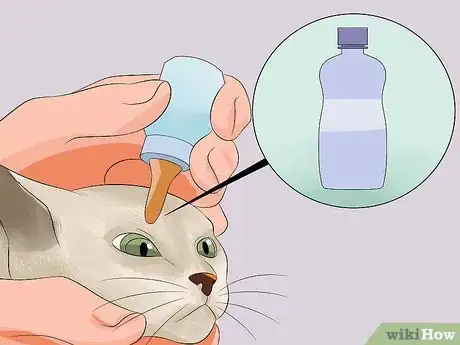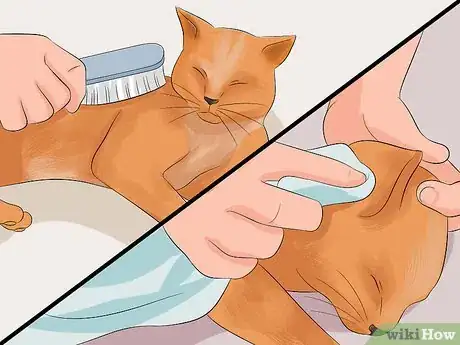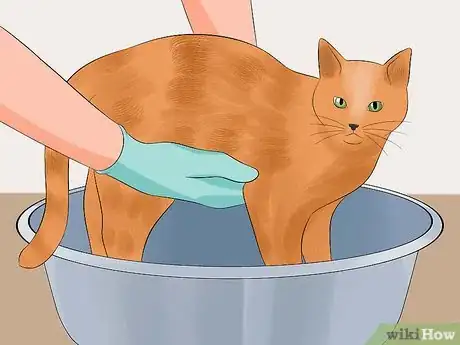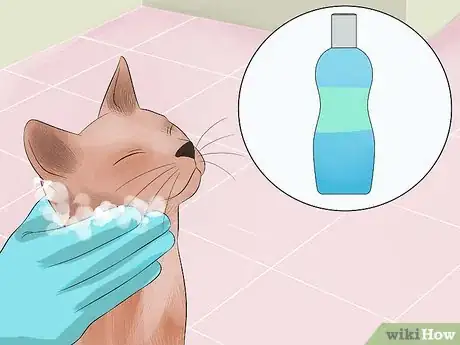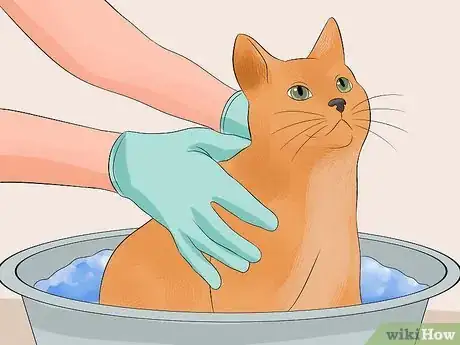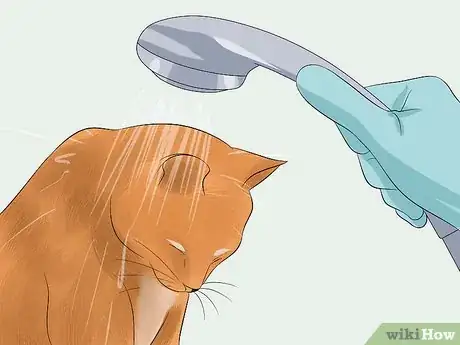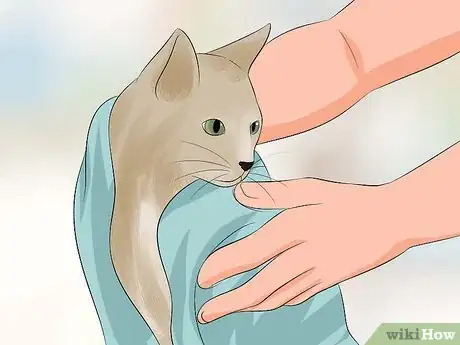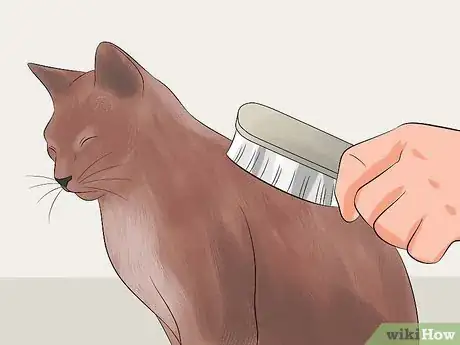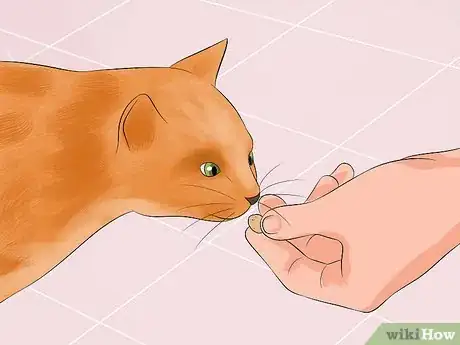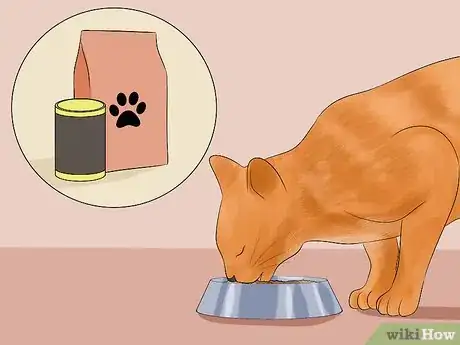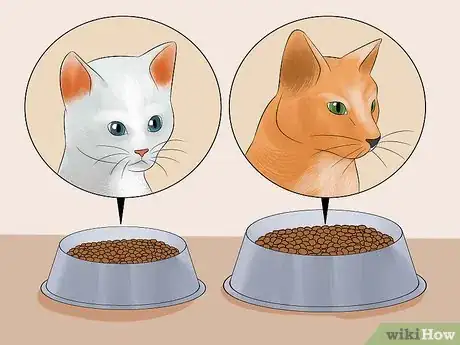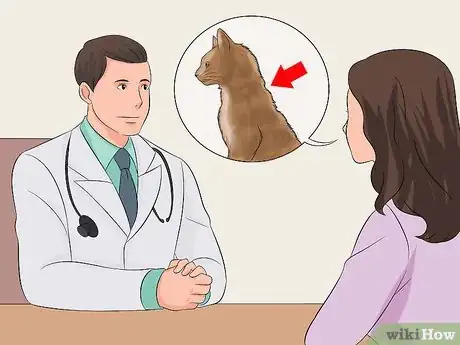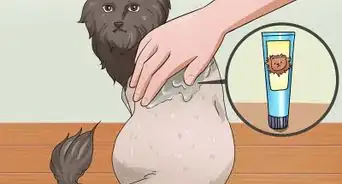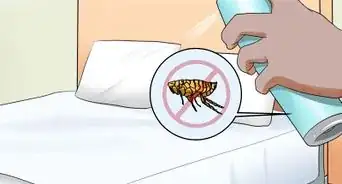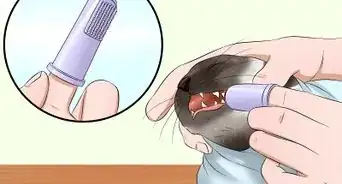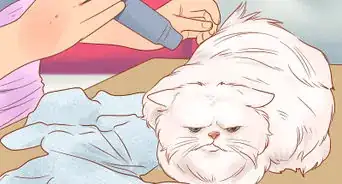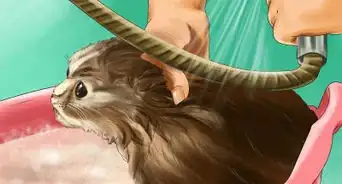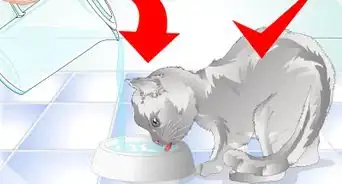This article was co-authored by Brian Bourquin, DVM. Brian Bourquin, better known as “Dr. B” to his clients, is a Veterinarian and the Owner of Boston Veterinary Clinic, a pet health care and veterinary clinic with three locations, South End/Bay Village, the Seaport, and Brookline, Massachusetts. Boston Veterinary Clinic specializes in primary veterinary care, including wellness and preventative care, sick and emergency care, soft-tissue surgery, dentistry. The clinic also provides specialty services in behavior, nutrition, and alternative pain management therapies using acupuncture, and therapeutic laser treatments. Boston Veterinary Clinic is an AAHA (American Animal Hospital Association) accredited hospital and Boston’s first Fear Free Certified Clinic. Brian has over 19 years of veterinary experience and earned his Doctor of Veterinary Medicine from Cornell University.
There are 11 references cited in this article, which can be found at the bottom of the page.
This article has been viewed 172,106 times.
A healthy coat of fur on a cat will be slick, smooth, and shiny, not coarse or brittle.[1] Proper nutrition and good grooming will help keep your cat’s fur healthy, whether it is a long-haired or short-haired variety. After you learn the basic steps to promoting healthy fur, it will be easy to incorporate them into your feline's care routine.
Steps
Brushing Your Cat
-
1Groom your cat to improve the look of its coat. Regular brushing will remove loose hairs, dirt, and external parasites. It will also help spread natural oils produced by your cat’s skin throughout its fur.[2] This will increase the overall shininess and sleekness of your cat’s coat.
- Brushing your cat frequently will also reduce the amount of fur that it swallows when grooming itself, thus reducing the number of hairballs it produces.
- Begin grooming your cat at a young age so that it will get accustomed to it.[3]
- Professional cat-grooming services may also be available in your area. Prices for these services can vary widely.
-
2Decide how often your cat needs brushing. Long-haired varieties of cats will need more frequent brushing than short-haired varieties. Long-haired cats will need to be brushed once every few days, while short-haired cats may only need grooming once a week.[4] Other experts suggest brushing long-haired cats for at least 15 minutes per day.[5]Advertisement
-
3Gather the supplies you will need. To brush your cat well, you will need a quality general brush, a steel comb, and a rubber or bristle brush.[6] [7] All of these should be versions designed specifically for cats.
- Optionally, a fine chamois or washcloth can be used to wipe your cat after brushing.[8] This will remove any remaining hairs and improve the shine of your cat’s coat.
-
4Carefully brush your cat. Starting with the general brush, stroke your cat’s fur softly, working from head to tail.[9] Next, use the steel comb the same way. This will help remove any dirt and debris. Finally, use a bristle or rubber brush, which will remove any loose hairs.
- If your cat’s fur has any tangles, carefully work those out before brushing its whole coat.
- If you wish, wipe your cat with a chamois or washcloth after brushing to maximize the shine of its coat.[10]
- Make sure to be gentle on your cat’s sensitive areas, such as its belly.
- To brush the tail of a long-haired cat, make a part down the middle and brush fur to either side.
Bathing Your Cat
-
1Decide when to bathe your cat. Cats are known to be self-grooming, and will only rarely need a bath.[11] However, if your cat can’t or won’t groom itself well, you may need to bathe it more frequently.
- How often to bathe your cat will depend on its breed and activity level. Long-haired or especially active cats, for instance, might need to be bathed more frequently. A cat that is arthritic and has difficulty grooming itself, however, might also need to be bathed more frequently.
-
2Prepare your cat for its bath. You may want to place cotton balls in your cat’s ears to keep water out of them.
- Choose a bath time when your cat is calm. Playing with your cat before giving it a bath might help to calm and tire it a bit so that the bath is less stressful.[12]
- Try to soothe your cat before the bath, by giving it a small treat, talking softly to it, or petting it.
- You may also want to clip your cat’s nails before bathing to protect yourself from scratches.
-
3
-
4Prepare the bath. Fill a tub or sink with enough warm (not hot) water so that you will be able to wet your cat, but not so much that it could be submerged. If you are using a tub or basin to bathe your cat in, place a towel or non-slip rubber mat in the bottom.[15] If your cat has something to hold onto during the bath, it might feel more secure and be calmer.
- Make sure that the room you will bathe your cat in is warm (70 degrees Fahrenheit or warmer), as your cat may become cold when it is wet.
-
5Carefully place your cat in the bath. You may need the help of another person to put your cat in its bath. Cats generally dislike water, and this step might be slightly stressful on yours.
- You may also want to protect your hands in arms from cat scratches and bites by wearing gloves and long sleeves when bathing your cat.
-
6Use the right kind of shampoo. Cats have different skin characteristics than humans, and so you should not use human shampoo or soap to bathe your cat.[16] Check your local pet supply store for shampoos and conditioners specially formulated for use on cats, or ask your veterinarian for advice.
- If your cat has skin allergies or other issues, your veterinarian may prescribe special shampoos. Be sure to carefully follow all accompanying instructions.
-
7Gently bathe your cat. Using just a bit of shampoo and lukewarm water (one part shampoo to five parts water), massage your cat’s fur. Work quickly but calmly, and be careful to attend to any problem areas (dirt, matted hair, etc.). Work from head to tail, being careful to avoid your cat’s eyes and ears.
- You can also use a gentle spray hose or bottle to wet your cat.[17]
- Talking to your cat in a soothing voice may make the bath less stressful.
-
8Rinse your cat thoroughly. Since cats are such persistent self-groomers, you can expect yours to start “cleaning” itself with its tongue and paws after you bathe it. Before you let your cat out of the bath, make sure to thoroughly rinse its fur free all traces of shampoo or conditioner, so that your cat does not accidentally swallow any.[18] Otherwise, your kitty might wind up with an upset tummy or other problems.
-
9Dry your cat. Once your cat is well-rinsed, remove it from the bath. Using a cloth or paper towel, blot its tail and legs to remove extra water. Wrap your cat in a towel to dry it. Keep it warm until its coat is dry.[19]
- If your cat is short-haired and your home is warm, it may be able to dry on its own without a towel.
- Hair dryers may not be a good choice for use on cats as they can dry out your cat's skin, or even cause them to have heat stroke; in addition, the noise may bother some cats. If you wish to use a hair dryer, make sure it is on the lowest (or “cool”) heat setting.[20]
-
10Brush afterwards if necessary. A bath alone may be enough to make your cat’s fur sleek and shiny. However, if its hair is long, tangled, or matted, you may find that brushing afterwards will help.[21]
-
11
Feeding Your Cat for a Healthy Coat
-
1Feed your cat a healthy diet. To have a healthy coat, a cat must eat a healthy diet. Whether your cat eats canned food, dry food, raw food, or a combination of these, its diet should be high in proteins and fats.[24] Your cat should also always have plenty of clean, fresh water to drink.[25]
- Talk to your veterinarian for specific advice about selecting the right foods for your particular cat.
-
2Serve your cat high-quality foods. Commercial cat foods can vary in quality. To ensure that your cat’s coat stays healthy-looking, check the food’s nutritional content (listed on the label) and make sure it matches your cat’s current needs.
-
3Change your cat’s foods when needed. Your cat’s dietary needs will vary throughout its lifetime; foods that are designed for kittens are not suitable for older cats, and vice versa. The nutrition your cat needs also depends on its individual factors, like health and activity level.[28] [29] If your cat is not receiving the right kind of food for its age and activity level, its coat may look coarse and dull.
-
4Contact your veterinarian if your cat’s coat seems inexplicably dull. If you are feeding and grooming your cat according to its needs, and its coat still seems dull, brittle, or coarse, talk to your veterinarian about the problem. Health problems, such as digestive issues, parasites, cancer, obesity, or stress can affect the appearance of your cat’s fur.[30] [31] Your veterinarian can determine if there is an underlying health problem causing the poor coat quality.
References
- ↑ http://www.saintfrancis.org/2014/01/spotlight-cats-healthy-skin-coat/
- ↑ http://www.saintfrancis.org/2014/01/spotlight-cats-healthy-skin-coat/
- ↑ http://www.vet.cornell.edu/FHC/health_information/NewCat.cfm
- ↑ http://iml.jou.ufl.edu/projects/Fall08/Weaver/groom.html
- ↑ http://www.extension.iastate.edu/mills/sites/www.extension.iastate.edu/files/mills/projects/Cat%20Grooming%20Tips.pdf
- ↑ http://www.vet.cornell.edu/FHC/health_information/NewCat.cfm
- ↑ https://www.aspca.org/pet-care/cat-care/groom-your-cat
- ↑ http://www.extension.iastate.edu/mills/sites/www.extension.iastate.edu/files/mills/projects/Cat%20Grooming%20Tips.pdf
- ↑ https://www.aspca.org/pet-care/cat-care/groom-your-cat
- ↑ http://www.extension.iastate.edu/mills/sites/www.extension.iastate.edu/files/mills/projects/Cat%20Grooming%20Tips.pdf
- ↑ http://www.saintfrancis.org/2014/01/spotlight-cats-healthy-skin-coat/
- ↑ https://www.aspca.org/pet-care/cat-care/bathing-your-cat
- ↑ https://www.aspca.org/pet-care/cat-care/bathing-your-cat
- ↑ https://www.aspca.org/pet-care/cat-care/bathing-your-cat
- ↑ https://www.aspca.org/pet-care/cat-care/bathing-your-cat
- ↑ http://www.saintfrancis.org/2014/01/spotlight-cats-healthy-skin-coat/
- ↑ https://www.aspca.org/pet-care/cat-care/bathing-your-cat
- ↑ http://www.saintfrancis.org/2014/01/spotlight-cats-healthy-skin-coat/
- ↑ https://www.aspca.org/pet-care/cat-care/bathing-your-cat
- ↑ https://www.aspca.org/pet-care/cat-care/bathing-your-cat
- ↑ https://www.aspca.org/pet-care/cat-care/bathing-your-cat
- ↑ https://www.aspca.org/pet-care/cat-care/bathing-your-cat
- ↑ Brian Bourquin, DVM. Cat Behavior Trainer. Expert Interview. 20 December 2019.
- ↑ http://feline-nutrition.org/answers/answers-why-did-my-cats-fur-get-so-silky
- ↑ https://www.aspca.org/pet-care/cat-care/cat-brushing-skin-care
- ↑ http://www.vet.cornell.edu/FHC/health_information/NewCat.cfm
- ↑ http://www.aafco.org
- ↑ http://www.saintfrancis.org/2014/01/spotlight-cats-healthy-skin-coat/
- ↑ https://www.aspca.org/pet-care/cat-care/cat-brushing-skin-care
- ↑ http://www.saintfrancis.org/2014/01/spotlight-cats-healthy-skin-coat/
- ↑ http://jn.nutrition.org/content/128/12/2783S.full
About This Article
To make your cat's fur soft and shiny, brush it at least once a week with a bristle or rubber brush to remove any loose hair. Then, follow up with a steel comb to pick up any dirt and debris. If your cat is especially dirty, wash its fur with a shampoo and conditioner formulated for cats. Finish by rinsing your cat's fur thoroughly with water and drying it off with a towel. For tips on how to feed your cat a healthy diet to make its fur shiny, keep reading!
